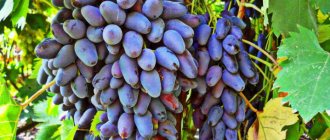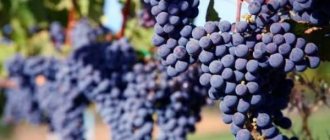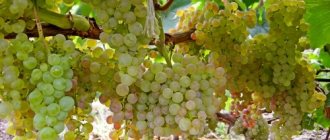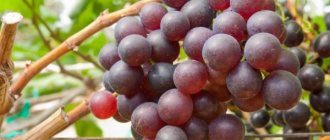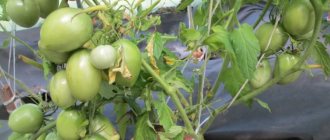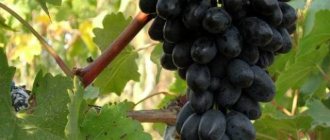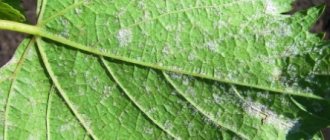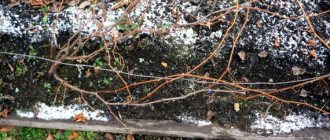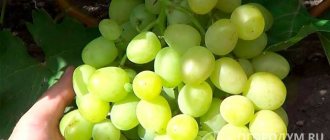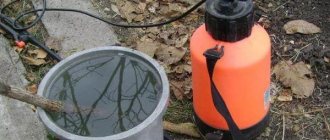Hybrid forms of grapes are breaking into our vineyards quickly and some are settling in them forever.
Amateur breeders give the world more and more new hybrid forms of grapes that are ready to surprise with the size of the berries, yield and taste. The hybrid form "Everest" is one of the representatives of such grapes.
Official information about the variety
Harmonious taste with a fruity tint.
Juicy and elastic flesh.
Early ripening.
The author of the form is breeder E. G. Pavlovsky, Zaporozhye, Ukraine.
Parental forms used to obtain the hybrid K-81 and “Talisman”. Breeding number of form B-12–1 .
Having chosen parental forms with win-win characteristics, the breeder “learned” market qualities, size and stability from the parents.
Description of the form
Sheet.
Crown.
Everest has enormous growth power.
- Having planted a seedling, the form can begin bearing fruit in the third year, bypassing the signal bunch stage. At the same time, wood growth occurs at a rapid pace.
- Based on the timing of maturation, the form was classified as early . Optimum ripeness occurs in mid-August.
- The leaf shape is five-lobed, strongly dissected.
Berry
Berry weight.
Fruit size.
Cross section of a berry.
- The color of the berry is uniform, beautiful pink at the beginning of ripening with the gradual addition of a bright rich pink color . When fully ripe and overripe, the berry acquires burgundy shades. The berry tends to fade slightly in the sun, while the shadow side retains the intensity of the color. Given this property, winegrowers are in no hurry to open the berries to the sun.
- Not all berries begin to gain color at once, but only those that have already gained weight of at least 15 g . The remaining berries grow patiently and only then catch up with the first ones in color. The berry intensively gains a pruin coating, which makes it a little lighter.
- The weight of the berry is on average 18–20 g . However, the scales sometimes recorded berries weighing up to 25 g. The shape of the berry is oval with a slightly narrowed tip. If we describe the berry itself, then, with its length of 4.5 cm and weight of 23 g, the seed has a length of 1 cm. At first it may seem like a lot, but the proportions are respected.
- According to the tasting assessment, it is defined as a grape with a harmonious taste . The skin gives the berry fruity tones; it is medium in thickness, but chewable. There is no nutmeg aftertaste. The ratio of sugars and organic acids is very balanced, which makes these grapes pleasant to consume both for lovers of sweet varieties and for those who do not crave the taste of sugar.
- Seeds 2, light color . A small feature distinguishes this form. The seeds are placed in the pulp as if in a cradle, forming a small void around themselves. When pressing on the flesh, they quickly release the “body”.
The berry is very juicy, but at the same time elastic.
Bunches
Initial fruiting shows a bunch of 500–600 g. However, the rapid accumulation of wood suggests that this form has enormous potential and subsequent harvests are predicted to weigh up to 800, or even 1000 g.
Clusters with large berries, without peas.
- Those who waited for fruiting for 3–4 years describe that even without the accumulation of wood, the bush produces clusters weighing 1200–1500 g . However, there are indications that the clusters are uneven. One bush carries both very large clusters and those that do not reach 500 g .
- The clusters are medium in density . Good pollination allows you to get a large, beautiful berry, but only after careful thinning.
- The shape of the bunch is conical, with well-defined wings.
Marketability
First signal.
One of the special indicators of this form is its presentation. At the market, such a berry is difficult not to notice and pass by.
Berry:
- does not crack;
- hangs on the bush for a long time without changing its organoleptic properties;
- has good transportability over long distances;
- behaves well after cutting;
- does not fall off the bunch;
- can be stored for a long time.
The fact that the berry holds well to the stalk is an undoubted plus of the hybrid form.
Another peculiarity of it when ripening is that after “sagging” for a month, it begins to soften slightly at the tips. This indicates overripeness. It is impossible to say that there is a deficiency in over-ripening, since each berry must be harvested on time, in accordance with its ripening time.
Everest grapes: variety description, care rules, photos and reviews
The Everest grape was bred by amateur breeder Evgeniy Georgievich Pavlovsky. The created hybrid variety is truly successful and worthy of special attention from farmers and winemakers. Everest berries are distinguished by their aroma and bright taste, as well as an excellent ratio of grape acids to sugars. This relatively new table variety is actively used not only as a raw material for winemaking, but is also often consumed fresh. The parent pair “talisman” and “k-81” provided the hybrid in question with excellent taste and commercial qualities, as well as relatively high frost resistance and resistance to dry periods.
Description of the form
The first planted seedlings can begin to bear fruit literally in the third year, bypassing the stage of the signal (first) bunch. Breeders note that wood formation occurs at a rapid pace. According to the ripening period, Everest grapes are classified as an early variety. The leaves of the plant are five-lobed and strongly dissected.
The fruits have a uniform, beautiful pink color. At the beginning of ripening, the grapes appear tinged with a slight addition of pink. When fully ripe and overripe, the berry of the hybrid in question acquires a dark burgundy hue. It is important to note that the fruits of the Everest grape variety tend to fade slightly in the sun, while the shadow side preserves the brightness of the color. Given this property, farmers are in no hurry to open the berries to the sun's rays.
Not all berries begin to acquire their color at once, but only those that have already gained a mass of at least 15 grams. Other grapes ripen patiently and only then catch up in color to the first ones. Ripe berries weigh on average 18–20 grams each. However, the scales sometimes indicated the weight of Everest grape fruits up to 25 grams.
The shape of the grapes is oval with a slightly narrowed tip, the length of the berries is 4.5 cm, and the seed is 1 cm long. Initially, it may seem that the fruits are incorrectly formed, but the proportions are still respected.
According to the tasting assessment (the photo of the Everest grapes also indirectly confirms this), the hybrid is defined as a plant with an attractive appearance and harmonious taste. The skin gives the berry fruity notes; it is medium in thickness, but perfectly chewable. There is practically no nutmeg taste. The proportion of sugars and organic acids is balanced. All this makes the hybrid pleasant to eat both for lovers of sweet varieties and for those who do not like to taste sugar.
Many farmers note that Everest grapes have beautiful symmetrical clusters, dense, with long branches, voluminous and slightly elongated. They reach a length of up to 35–40 cm and a weight of about 0.7–1 kg. In a bunch, the grapes hang very tightly to each other.
Harvesting occurs in 3–4 years. Even without the formation of a sufficient amount of wood, the Everest grape bush produces clusters weighing up to 1.2–1.5 kg. However, during this period, the appearance of uneven shoots can be observed. One bush can produce both very large clusters and those that weigh no more than 0.5 kg.
Good pollination of the crop allows you to get a large and beautiful berry, but only after good thinning. The shape of the vine is conical with well-defined wings.
Agrobiological description of the variety
The vine variety "Everest" is characterized by great growth vigor. The ripening of shoots occurs by September by 80-85%. Pruning is preferably medium and long. Bushes are not prone to overload.
The yield reaches 20 kilograms of berries per bush. Harvesting and technical ripeness of this hybrid occurs on the 115th day, that is, approximately in mid-August.
"Everest" can withstand short-term frosts down to -23 degrees in winter. It is advisable to cover the vine of this variety in regions where winter temperatures are below this limit.
Characteristics of brushes:
Berries are not afraid of excess moisture. Cracking occurs extremely rarely in the most unfavorable years. Everest is not affected by wasps.
The clusters are very beautiful, dense with long branches, voluminous, elongated. They can reach 35-40 centimeters in length and weigh about 0.7-1.0 kilograms. The berries in the bunch hang tightly to each other.
Important! To prevent the berries in the bunches from being crushed, in some cases after flowering it is necessary to thin out the bunch.
Description of berries:
The color of the grains is pink-red, but when hanging on the bushes for a long time, the color becomes intensely red.
It is useful to know that berries can “burn out” in the sun, that is, their color fades. Therefore, it is best to grow these grapes in the shade of the leaves.
The grain of this variety is elongated and almond-shaped. The length of the grain is about 26-32 and the width is 25-28 millimeters. The weight of the berries reaches 16-20 and even 30 grams. Tasting score of the Everest variety is 8.0 points.
Taste and marketability of the Everest variety
The taste of the Everest variety is very good. The flesh is juicy, but at the same time crispy. The skin has a fruity taste, is dense, of medium thickness, easily eaten and tightly adhered to the pulp. There are no more than two seeds in each grain of grapes and they are easily cracked. The form gains sugar quickly and at the same time the balance of acids in the berries is such that even at the beginning of coloring the berries already have a pleasant taste and do not become sour. And further coloring of the berries only improves its taste.
Even under normal conditions, the variety can last up to 3-4 months, and in refrigerators the shelf life can be even longer.
The hybrid form "Everest" tolerates transportation very well, due to the fact that the berries adhere tightly to the ridges and are not subject to cracking.
Marketability
According to the description of the Everest grape, the berry has high rates of transportability. The medium-thick skin protects the fruit well from negative environmental influences and all kinds of damage. The berries can easily withstand long-term transportation and are stored well.
One of the special characteristics of this hybrid is its attractive presentation. At the market, such bunches are hard to miss and pass by. According to the description of the Everest grape variety, the fruits are:
- do not crack;
- stay on the bush for a long time, without changing their organoleptic properties;
- have high transportability even over long distances;
- They are stored for a long time after being cut from the bush.
A distinctive feature of the hybrid berries when ripe is that after “sagging” for up to 30 days, they soften a little at the tips, this indicates over-ripening. The state of over-ripening is not a minus for the fruits of Everest grapes, but it is better to pick the berries on time, according to the ripening period.
The taste properties of the Everest table variety are good, the fruit pulp is juicy and even slightly crunchy. The skin is well fused with the pulp, has medium thickness and is quite easy to chew. There are no more than two seeds in each grape, and they are easily cracked without emitting bitterness. The fruits gain sugar quickly, and the balance of acids in them is such that even at the beginning of the ripening period they acquire a pleasant taste and do not become sour. Subsequent ripening of the fruit only improves its taste.
Berries
The fruits have a uniform, beautiful pink color. At the beginning of ripening, the grapes appear tinged with a slight addition of pink. When fully ripe and overripe, the berry of the hybrid in question acquires a dark burgundy hue. It is important to note that the fruits of the Everest grape variety tend to fade slightly in the sun, while the shadow side preserves the brightness of the color. Given this property, farmers are in no hurry to open the berries to the sun's rays.
You may be interested in: Tomato “Budenovka”: description of the variety, photos, reviews, characteristics, yield, cultivation in a greenhouse
Not all berries begin to acquire their color at once, but only those that have already gained a mass of at least 15 grams. Other grapes ripen patiently and only then catch up in color to the first ones. Ripe berries weigh on average 18–20 grams each. However, the scales sometimes indicated the weight of Everest grape fruits up to 25 grams.
The shape of the grapes is oval with a slightly narrowed tip, the length of the berries is 4.5 cm, and the seed is 1 cm long. Initially, it may seem that the fruits are incorrectly formed, but the proportions are still respected.
According to the tasting assessment (the photo of the Everest grapes also indirectly confirms this), the hybrid is defined as a plant with an attractive appearance and harmonious taste. The skin gives the berry fruity notes; it is medium in thickness, but perfectly chewable. There is practically no nutmeg taste.
Advantages and disadvantages of the variety
According to the description, the Everest grape variety, the photo of which is presented below, has the following advantages:
- farmers can count on an early and stable harvest;
- grape berries have an attractive appearance and excellent taste;
- no tendency to pea;
- there is no rapid cracking of fruits;
- excellent rooting of cuttings;
- high adaptability to all kinds of climatic conditions;
- resistance to major diseases and damage by pathogenic microorganisms;
- the crop is transported well.
Read also: Zucchini Yasmin f1: reviews, description of the variety
Let’s also highlight the disadvantages of the variety:
- still unstudied winter hardiness;
- the crop should be additionally insulated;
- A huge area is required for cultivation.
Description and characteristics of the variety
Everest took all the best qualities from the original varieties - large berries, beautiful appearance, excellent taste, immunity to fungal diseases and pest attacks.
Bushes
The grape variety is mid-early, characterized by high survival rate, vigor and ripening along the entire length. The leaf blades are openwork, heart-shaped, large, five-lobed, dissected. From the time the buds appear until the fruits ripen, it takes 110-120 days.
Flowers
The flowers are hermaphrodite and are able to pollinate themselves. The variety participates in pollination of other plants with unisexual flowers. It is recommended to thin out the ovaries to obtain large berries.
Bunches and berries
Cone-shaped or cylindrical bunches of grape varieties have:
- attractive presentation;
- medium density;
- large sizes;
- weighing 500-800 g.
The juicy and elastic berries are oval, 4.5 cm long, weighing 18-20 g. Pink at the beginning of ripening, then red-violet with a dense waxy coating. There are 2 seeds in each, they are easily separated when pressed. If not properly cared for, large and small berries ripen on the same vine. The variety has a sweet taste, without sourness or nutmeg aftertaste.
This variety is not recommended for wine.
Productivity
The harvest rates are high; at least 25 kg of bunches are harvested from the bush. Gardeners grow the Everest variety for personal use and for sale. Harvesting begins in the middle or end of August, the timing depends on the region.
Transportability
The skin of grapes protects the fruit from damage and external factors. Thanks to it, the variety tolerates transportation well over long distances and is stored for a long time.
Frost resistance
The variety tolerates frosts in the southern and middle regions. Otherwise, frost resistance has not been fully studied. The bushes need to be covered for the winter, especially if the temperature reaches -20 C. This will guarantee a future harvest of berries.
See also
Description and characteristics of the grape variety Fun, history and subtleties of cultivationRead
Resistance to diseases and pests
The variety is resistant to fungal diseases, pests, and is not afraid of wasp invasion. Only preventive treatments are carried out.
Subtleties of landing
According to reviews, descriptions and photos of the variety, Everest grapes are propagated by seeds, cuttings, by grafting cuttings to seedlings or by grafting another variety. The second method takes a significant amount of time. Many winegrowers initially sow seeds in a plastic or peat pot. When the young grapes reach a height of 10–15 cm, they are transferred to open ground. This process takes on average 2–3 years.
Propagation by cuttings is quite feasible only if there is already at least one Everest grape bush on the site. To do this, one or more strong vines are bent down and covered with soil. Reproduction in this way is recommended in spring or autumn.
Many farmers recommend planting the unpretentious and undemanding Everest variety in the second half of April. The planting site should be found on a hill with normal protection from the wind and good lighting, which is important for crop formation.
Almost any soil is suitable for growing crops. "Everest" can successfully produce crops even when growing on rocky slopes. The main advice is to avoid close proximity to groundwater and places where spring flooding occurs.
According to the experience of many farmers, the crop likes to grow best on the south side. When forming holes for planting grapes, half a bucket of humus is placed at the bottom.
Biological description and characteristic features
The Everest table grape variety was obtained by crossing such varieties as B-12-1, Talisman and K-81, and the authorship belongs to the famous breeder E.G. Pavlovsky. The new hybrid inherited only the strengths of its ancestors. Everest grapes were developed quite recently, so they are still under study.
Like any grape, Everest loves sunlight and does not like cold winds. With this in mind, you need to choose a landing site.
It is better to plant seedlings in spring (mid-March, early April).
Planting material must have a well-formed root system and at least 4 buds per cutting.
Planting stages:
- If possible, dig a hole (80x80x80) in advance and warm it up (How to speed up fruiting);
- we apply fertilizers;
- After planting for the first time, you may need to cover with film if spring frosts are possible.
The disease resistance of the variety is being studied. In our nursery we carry out two standard preventive treatments.
Frost resistance is also unknown. In the Kharkov region, we bend the vine to the ground and cover it.
Care stages:
- we weed out the weeds in a timely manner, loosen the soil around the bush, and mulch;
- water as needed;
- add fertilizer;
- we pinch the tops of fruiting vines at the end of July for better ripening;
- we protect the crop from birds and wasps;
- we treat against pests;
- in the fall we prune and shape the bushes to plan next year’s harvest. Pruning on a single-plane trellis with 6-8 eyes. In some cases, thin out and standardize the crop after flowering;
- in regions with winters where the temperature drops below 24C°, we cover it for the winter.
The appearance indicators are outstanding, very high marketability and transportability. I think this variety has a good future, the appreciation of winegrowers and the love of consumers.
The success of growing grapes depends on proper planting, proper selection of site, planting material and soil.
Berry bushes can be planted both in autumn and spring. The exact planting dates will depend on climatic conditions.
In autumn, planting occurs in mid-October. After being placed in the ground, the bushes are immediately covered for the winter.
In spring, grapes are planted when stable warm weather sets in: from late March to mid-April. Those seedlings that have green shoots should be planted later - in May or June. If there is a forecast for return frosts, the bushes will also need to be covered.
The best area for planting grapes is a well-lit, unshaded place, sheltered from the winds. An excellent location option is the south or southwest side of the building, along the fence.
It is necessary to ensure that there is no groundwater close to the site. They should be located at a depth of 2–2.5 m. Also, there should be no flooding on the site in the spring.
When planting, you should maintain the recommended gap between the bushes - 1.5–2 m. A minimum distance of 1 m should be maintained from the building to the grapes.
Everest grapes are undemanding to soil. Loam, sandy loam, clayey, sandy and even rocky soils are suitable for growing grape bushes.
Grapes can be propagated in 2 ways:
- Saplings.
- Grafting cuttings.
Cuttings for spring planting should be prepared in the fall. Root them in a container with water. Then they need to be stored in cool conditions. Before planting, carefully check the area for the presence of phylloxera.
The technology for planting seedlings is as follows:
- 10–14 days before the planned planting, prepare a hole with dimensions corresponding to the root system of the plants: on average about 80 cm in depth and width.
- At the bottom of the planting hole, add layers of nutrient-rich soil, 0.5 buckets of humus, and fertile soil.
- On the day of planting, trim the seedling, leaving 2 shoots with 2 eyes.
- Then place it in the center of the hole so that the root collar is level with the edge.
- Spread out the roots.
- Fill with the remaining soil.
- Lightly compact.
- Water generously.
- Install a trellis or support pegs.
- Mulch the tree trunk circle with mowed grass, peat, sawdust, moss, etc.
If seedlings are purchased in a store, then you need to choose those that have at least 2 strong roots and 2 buds.
To plant using grafting, you need:
- Cut off the old bush, leaving 10 cm from the soil.
- Split the stump into 2 parts.
- Insert the cut end of the scion into it.
- Make a tight tie.
- Coat generously with moistened clay.
According to reviews, descriptions and photos of the variety, Everest grapes are propagated by seeds, cuttings, by grafting cuttings to seedlings or by grafting another variety. The second method takes a significant amount of time. Many winegrowers initially sow seeds in a plastic or peat pot. When the young grapes reach a height of 10–15 cm, they are transferred to open ground. This process takes on average 2–3 years.
Propagation by cuttings is quite feasible only if there is already at least one Everest grape bush on the site. To do this, one or more strong vines are bent down and covered with soil. Reproduction in this way is recommended in spring or autumn.
Many farmers recommend planting the unpretentious and undemanding Everest variety in the second half of April. The planting site should be found on a hill with normal protection from the wind and good lighting, which is important for crop formation.
Almost any soil is suitable for growing crops. "Everest" can successfully produce crops even when growing on rocky slopes. The main advice is to avoid close proximity to groundwater and places where spring flooding occurs.
According to the experience of many farmers, the crop likes to grow best on the south side. When forming holes for planting grapes, half a bucket of humus is placed at the bottom.
Grape resistance to frost and disease
Today it has not yet been clarified whether it is possible to obtain a normal harvest if the crop is planted in the northern regions of the country. Therefore, it is impossible to declare 100% that “Everest” is completely frost-resistant.
Winter hardiness, according to reviews of Everest grapes, has not yet been sufficiently studied. Since the hybrid was created relatively recently, many experts have not yet had time to study it well. To avoid crop loss, farmers advise that the plant be insulated for the winter. In autumn, when the first frost occurs, it is important to wrap the grape bushes using the dry method. That is, the vine is carefully rolled up and placed on pre-prepared boards. The branches are covered with several layers of non-woven material. Many farmers cover the vines with dry sawdust. After the branches have been insulated, be sure to construct a top layer of film or roofing material; it will help protect the crop from moisture.
The first treatment measures should be carried out when young leaves appear. To do this, you can use “Tiovit Jet” in a dosage of 40 grams per 9–10 liters of water. Such treatment will prevent the development of diseases such as oidium, Phomopsis and rubella.
“Everest” did not show a tendency to be highly infected with diseases. The crop is not susceptible to dangerous diseases such as powdery mildew, mildew, and gray rot. However, the key to a high-quality harvest is precisely the preventive treatment of the crop. The presence of a dense skin reliably protects the juicy pulp from insects and small pests. Grapes are not afraid of bees and wasps.
Main characteristics
"Everest" is characterized by a short growing season. From the moment the buds open, the fruits ripen after 120 days. This allows you to harvest ripe and juicy fruits already in mid-August.
Bushes
The Everest variety takes root well and easily adapts to environmental conditions. The bushes are characterized by good growth vigor and excellent ripening of the vine along the entire length. The formation of a large number of fruit-bearing stepsons greatly facilitates the reproduction process. However, due to the presence of large bunches, it is necessary to monitor the load on the bush and prune it on time.
Flowers
The presence of bisexual flowers has a beneficial effect on the process of reproduction and development. This allows the plant not only to pollinate itself, but also to participate in the pollination of other crops. The proximity of “Everest” to grape varieties with unisexual flowers is very advantageous.
Bunches and berries
Large clusters of grapes deserve special attention. They have a cylindrical shape and a dense structure in which the berries are located close to each other. The weight of an individual bunch varies from 0.6 to 1.2 kg.
The berries are large, oval in shape, weighing 15-25 g. The pulp is juicy and dense, covered with a thin but durable skin that is barely perceptible while eating. The amazing dark red color of the berries, covered with a thick pruin coating, gives them a chic appearance. “Everest” received excellent taste thanks to its pleasant sweet taste and harmonious aroma.
Productivity
High yield rates never cease to amaze winegrowers. Excellent commercial qualities and appearance allow the variety to be bred for personal use and for sale. Beautiful and large fruits are just beginning to conquer the market, but the demand for them is increasing every year.
Transportability
Bunches of grapes have good transportability. The reliable skin perfectly protects the berries from external influences and damage. The fruits can easily withstand long-term transportation and are stored well.
Frost resistance
Due to little study of the variety, the frost resistance threshold of grapes is not known. However, Everest has proven its resistance to slight cold and frost. This allows the crop to be grown not only in the southern but also in the middle regions.
Advice! In order to prevent and protect the plant from freezing, it is recommended to cover the bushes for the winter. The reliability and durability of the covering material depends on the climatic conditions of the area.
Resistance to diseases and pests
Everest did not show a tendency to be highly susceptible to diseases. It is not susceptible to the most dangerous diseases, such as oidium, mildew, and gray rot. However, the key to a high-quality harvest will be preventive treatment of grapes. The presence of a dense skin reliably protects the juicy pulp from insects and small pests. Grapes and wasps are not afraid.
Prevention measures
In order to protect plants from insects, rodents and fungal infections, preventive measures can be taken. The first thing experts do is spring spraying of the vines and soil. To do this, use a 3% solution of iron or copper sulfate.
The second spraying is carried out during the period of bud break and the appearance of the second leaf. To do this, take drugs with antifungal action. It is also necessary to carry out a third spraying of Everest grapes before flowering begins, for which they use “cocktails” of antifungal drugs, insecticides and foliar feeding.
Subsequent spraying of the bushes is carried out only as diseases appear, and also taking into account the epidemiological situation in the grape growing region. If specialists carried out prevention in a timely and competent manner, then further spraying may not be useful. As can be seen from the article, there is nothing difficult about growing Everest grapes.
Botanical description
The Everest grape was bred by the famous breeder E.G. Pavlovsky by crossing the varieties Talisman and K-81. The hybrid ripens in the mid-early period - in the last ten days of August or September. The period from bud break to harvest is 110-120 days.
The Everest variety has a table purpose. The clusters are large, weighing 700 g, in the shape of a cone or cylinder, of medium density.
The bushes have great growth vigor and form powerful shoots. The flowers are bisexual, planting pollinators is optional.
Description of the variety and photo of Everest grapes:
- large berries;
- average fruit weight 12 g;
- oval shape of berries;
- red-violet color;
- thick waxy coating.
The berries are distinguished by their fleshy and juicy pulp. The taste is simple but harmonious. The fruits are not subject to rotting and cracking. Berries on one bunch may differ in size and color.
After ripening, the clusters can remain on the bushes for a month. After aging, the taste only improves, and nutmeg notes appear in the berries.
Read also: Preparing apple trees for winter: how to cover and insulate, step-by-step guide with photos
Everest berries are consumed fresh and used for making desserts, jams, and juices. The fruits tolerate long-term transportation well.
Description of characteristics
Information about Everest has to be collected bit by bit from the author’s description, the first signal harvests and discussions on the forum.
Ripening period is early. The growing season is 115–120 days from the moment the buds open. Full ripening occurs in the second ten days of August, simultaneously with another form of Pavlovsky - Monarch.
The clusters are large, of medium density, with a very beautiful elegant appearance. The flower is bisexual, pollination is good. The weight of one bunch ranges from 600–1200 grams.
The berry is very large, oval in shape, dark red in color with a thick pruin coating. The weight of individual berries reaches up to 25 grams. The pulp is fleshy, juicy, covered with a dense but easily eaten skin. During cultivation I was not affected by wasps. No cracking of berries was observed either. I noticed this feature - small voids can form around the seeds, the so-called cucumber effect. A similar thing was observed with Bogatyanovsky berries.
The taste is harmonious without any special frills, but good. Most who try Everest like it.
The bushes are vigorous, and the vine ripens well and to its full length. For those who are going to propagate in their own root culture, I will say that the rooting of cuttings is excellent.
It’s too early to judge the resistance of grapes to diseases and frosts, but I think it will be no worse than other complex-resistant forms.
[adsp-pro-2]
I would also like to add that Everest can hang on a bush for a long time without losing its qualities, while the berry becomes dark burgundy in color. It will probably be stored well too, time will tell. Everest clusters are well transported and have high marketability.
The characteristics of this variety are impressive, since the plant is distinguished by vigorous bushes, and the vine is capable of ripening to its entire length. Large clusters of medium density and characterized by a beautiful elegant appearance attract attention. The weight of an individual bunch varies from 600 to 1200g. The culture produces bisexual flowers, which makes it possible to grow the crop without a pollinator.
Large oval-shaped berries are dark red with a thick waxy coating. The average weight of one fruit is in the range of 15 - 25 g. The pulp is juicy and meaty. The skin is dense, but when consumed it is almost not felt and is easily eaten. Berries of harmonious taste with a pleasant aroma.
The growing season from the moment of bud break is about 115-120 days. Technical ripeness occurs in mid-August.
We invite you to take a closer look at the external characteristics and taste characteristics of the hybrid in question.
Everest's brushes are large and attractive in appearance. In shape they resemble a cone or a cylindrical cone. Their density is average. Transportability is good. The weight of one piece varies from 0.6 to 1.2 kg.
Description of berries
Large grapes in the form of ovals are formed in the clusters. When mature, they are dark red in color with a thick waxy coating. On average, 1 grape can weigh from 15 to 25 g.
The shoots of this hybrid grow quickly and grow very tall. The vine is capable of ripening to its entire length.
The pulp of the grapes is juicy and meaty. It contains a small number of seeds. The skin is dense, but chews well when consumed. The taste and aroma of the pulp is pleasant.
Productivity
There are no exact data on the yield level of Everest grapes in open sources. She is reported to be tall. The hybrid is suitable for both personal use and sale.
Transportability
Having a fairly dense skin, the grapes are able to withstand transportation well and remain undamaged after it, suitable for consumption and sale.
It is currently unknown how resistant Everest is to cold weather.
We have already noted that the Everest hybrid is a new variety on the market, and many of its features have not yet been studied. One of the unknown abilities of this hybrid includes resistance to ailments and harmful insects characteristic of grapes. According to observations, its grapes are rarely affected by wasps.
Planting grapes
The place for growing Everest grapes is chosen taking into account lighting, wind load, and soil fertility. Seedlings are purchased from trusted suppliers to prevent the spread of diseases and pests. Planting pits are pre-prepared, where mineral fertilizers or organic matter are added.
Selecting a location
A sunny area, protected from the wind, is allocated for the vineyard. When in the shade, the bushes develop slowly, and the berries do not gain sugar. It is better to arrange the beds on a hill or in the center of a slope. In lowlands where moisture and cold air accumulate, the crop is not planted.
In cool climate regions, Everest grapes are grown on the south side of a house or fence. This way the plants will receive more heat.
Bushes are placed at a distance of more than 3 m from fruit trees. The crown of trees should not cast a shadow on the vineyard. Fruit trees require a large amount of nutrients. Therefore, when planted close together, the grape bushes will not receive the necessary nutrition.
Growing green manure will help enrich poor soil before planting grapes. In spring, the soil is dug up and legumes, mustard, and peas are planted. The plants are watered regularly, and after flowering they are cut and buried in the ground to a depth of 20 cm. In the fall, planting work begins.
Work order
Everest grapes are planted in October or spring after the snow melts. It is preferable to carry out work in the fall so that the seedlings have time to take root before the weather gets colder.
Seedlings are purchased from nurseries. For planting, choose healthy plants that do not have cracks, dark spots, or growths on the roots. The optimal length of the seedling is 40 cm, the thickness of the shoots is from 5 to 7 mm, the number of buds is 3 pcs.
The grapes take root well both on rootstocks and on their own roots. In spring, planted bushes begin to actively develop and produce new shoots.
Grape planting procedure:
- Dig a hole measuring 60x60 cm to a depth of 60 cm.
- Place a drainage layer of crushed stone or expanded clay at the bottom.
- Prepare fertile soil, mix it with 3 buckets of humus and 2 liters of wood ash.
- Fill the hole with substrate and cover with plastic wrap.
- After 3 weeks, when the soil has settled, plant the grapes.
- Water the plant thoroughly.
During the first time after planting, water the Everest bushes every week with warm water. Mulch the soil with humus or straw to reduce the number of waterings.
Specifics of growing crops
To form large and sweet berries, you should know the principles of cultivation and care.
Selection and preparation of a landing site
Choose a sunny, windless place for planting, with light, fertile soil. In a shady area, the bushes grow slowly, the berries will be unsweetened. The best site is a slope, a hill. In areas with a cold climate - a place on the south side. Fruit trees should grow at a distance of more than 3 m.
Preparation of planting material
Seedlings of the Everest variety are still not widespread; it is advisable to take them from a nursery. The cuttings must be healthy, without cracks, spots, or growths on the roots. Length 40 cm, thickness - 5-7 mm, number of buds - 2-3 pcs. Before planting, they are soaked in humate and the ends are trimmed.
Work order
The crop is preferably planted in October, or in early spring, after the snow melts. Dig a hole 60 x 60 wide and 60 cm deep, pour drainage from crushed stone and expanded clay onto the bottom. The soil is mixed with humus and wood ash. Fill the planting hole and cover it with film. After 3 weeks you can plant. A support is placed on the north side to support the vine. Planting material is placed in the middle of the hole, covered with soil, compacted, and watered.
To enrich the soil, the following method is used: in the spring, the area is sown with peas, and in the fall, they are added 20 cm deep.
Variety care
Everest grapes produce high yields with proper care. The plantings are watered, fertilized with useful substances, and the vines are pruned in late autumn. To prevent diseases and the spread of pests, preventive treatments are performed.
Young bushes of the Everest variety need intensive watering. Grapes under 3 years old are watered several times per season:
- in spring when buds open;
- before flowering begins;
- during harvest formation.
For irrigation, take warm water that has settled and warmed in barrels. Stagnation of moisture negatively affects the development of grapes: the roots rot, the development of the bush slows down, and the berries crack.
Mature grapes do not need constant watering. Its roots are capable of extracting moisture from the soil. In late autumn, bushes of any age are watered abundantly. The procedure protects the bushes from freezing and helps them survive the winter.
Regular fertilizing ensures stable fruiting of Everest grapes. Natural and mineral fertilizers are used for processing. If useful substances were added to the soil when planting bushes, then fertilizing begins at 2-3 years.
Grape processing scheme:
- in spring when buds open;
- 3 weeks after flowering;
- when berries ripen;
- after harvest.
The first fertilizing is carried out in the spring using nitrogen fertilizers. The bushes are watered with mullein or bird droppings diluted with water in a ratio of 1:20. In the absence of natural fertilizers, 20 g of urea is incorporated into the soil.
In the future, nitrogen fertilizers are abandoned in favor of substances containing phosphorus and potassium. Phosphorus substances promote the accumulation of sugar in berries and accelerate the ripening of grapes. Potassium improves the resistance of fruits to rotting and improves their taste by reducing acidity.
After flowering, the plants are fed with a solution consisting of 100 g of superphosphate and 50 g of potassium salt. The substances are dissolved in 10 liters of water. The resulting solution is sprayed onto the plants over the leaves. The treatment is repeated when the first berries are formed.
In the fall, after the harvest, the soil in the vineyard is dug up and 2 buckets of humus are added per 1 square meter. m. Fertilizing helps restore the strength of the grapes after fruiting.
Due to proper pruning, the Everest variety bush is formed. A total of 4 powerful shoots are left. The vine is cut to 8-10 eyes. The procedure is carried out in October after leaf fall. In the spring, the bushes are inspected and dry and frozen shoots are removed.
In the summer, the stepsons and leaves that cover the bunches from the sun's rays are plucked off. No more than 2 inflorescences are left for the shoot. Increased load leads to a decrease in the weight of the bunches and delays the ripening period of the crop.
Protection from diseases and pests
If agricultural practices are followed, Everest grapes remain resistant to major grape diseases. For prevention, plants are treated with a solution of Ridomil or Topaz. Ridomil is effective against mildew, Topaz is used to combat oidium and powdery mildew. The substances penetrate the above-ground parts of the grapes and protect them from the spread of fungus.
Read also: How to choose potatoes for the winter at the market: buying tips, video
The procedure for treating grapes against diseases:
- in spring when the first leaves appear;
- a couple of weeks after flowering;
- after harvest.
If necessary, spraying is repeated, but not more than twice a month. The last spraying is carried out 3 weeks after harvesting the grape bunches.
The vineyard attracts gall midges, leaf and spider mites, leaf rollers, and beetles. The drugs Karbofos, Actellik, and Aktara work well against insects. Preventive spraying is carried out in spring and autumn. Chemicals are used with caution during the growing season.
Shelter for the winter
The Everest variety requires mandatory shelter for the winter. In the autumn, after the leaves fall, the vines are removed from the supports and laid on the ground. The culture tolerates temperatures down to +5 °C. If the temperature continues to drop, then it is time to cover the plantings for the winter.
The grapes are hilled and mulched with dry leaves. Wooden boxes or metal arches are installed on top. Agrofibre or burlap is used for shelter.
It is important for grapes to provide air exchange, so it is better to avoid using plastic film. Additionally, a snowdrift is thrown over the bushes in winter. In spring, the shelter is removed so that the vine does not rot.
Everest grapes - description of the variety
Table varieties of amateur selection are especially popular among winegrowers. Almost all of them have high taste characteristics and yield indicators. Experienced winegrowers treat hybrid varieties of Pavlovsky selection with special trepidation.
Of its new hybrid varieties, it is worth noting the early ripening Everest grapes. It is distinguished by spectacular large clusters and high rates of transportability. At the moment, the Everest grape variety, due to its novelty, is an exclusive product on the grape seedlings market.
Varietal characteristics
The description of the Everest grape variety is as follows:
Early ripening. The length of its growing season does not exceed 120 days.
Large bunches, the weight of which, with good care, can exceed 1 kg. Also, according to the photo of Everest grapes, they do not have peas.
The flowers are bisexual, which allows varieties to be grown without a pollinator.
Also, Everest grapes, according to the description of the variety and photo, are characterized by berries of a rich red color with very high taste characteristics. Their weight, subject to the rules of formation and agricultural cultivation techniques, can reach 25 grams.
The description of the Everest grape variety, its photos and reviews about it indicate the excellent commercial qualities of the berries and high rates of transportability. There is also practically no such undesirable phenomenon as cracking of berries and their damage by wasps.
According to the description of the variety and photos from the forums, Everest grapes have excellent ripening of shoots and high rates of rooting of cuttings. This significantly increases winter hardiness and simplifies the process of propagation. Also, Everest Pavlovsky grapes are quite resistant to major diseases.
Bunches
Many farmers note that Everest grapes have beautiful symmetrical clusters, dense, with long branches, voluminous and slightly elongated. They reach a length of up to 35–40 cm and a weight of about 0.7–1 kg. In a bunch, the grapes hang very tightly to each other.
Harvesting occurs in 3–4 years. Even without the formation of a sufficient amount of wood, the Everest grape bush produces clusters weighing up to 1.2–1.5 kg. However, during this period, the appearance of uneven shoots can be observed. One bush can produce both very large clusters and those that weigh no more than 0.5 kg.
Good pollination of the crop allows you to get a large and beautiful berry, but only after good thinning. The shape of the vine is conical with well-defined wings.
